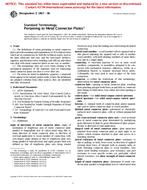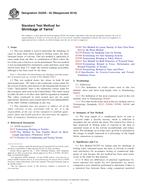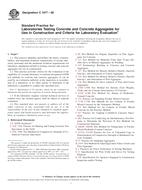1.1 This test method is commonly referred to as the Sequence VG test² and has been correlated with vehicles used in stop-and-go service prior to 1996, particularly with regard to sludge and varnish formation.³ It is one of the test methods required to evaluate oils intended to satisfy the API SL performance category.
1.2 The values stated in SI units are to be regarded as standard.
1.3 This standard does not purport to address all of the safety concerns, if any, associated with its use. It is the responsibility of the user of this standard to establish appropriate safety and health practices and determine the applicability of regulatory limitations prior to use. Specific hazard statements are given in 7.7, 7.10.2.2, 8.3.4.2, 8.4.4.3, 9.2.6, 9.3.4.5, 12.1.1.7, 12.2.1.4, and Annex A1.
1.4 A Table of Contents follows:
| Section | |
| Scope | 1 |
| Referenced Documents | 2 |
| ASTM Standards | 2.1 |
| SAE Standards | 3.2.3 |
| ANSI Standard | 2.2 |
| Terminology | 3 |
| Definitions | 3.1 |
| Definitions of Terms Specific to This Standard | 3.2 |
| Summary of Test Method | 4 |
| Significance and Use | 5 |
| Apparatus-General Description | 6 |
| Apparatus-The Test Engine | 7 |
| Sequence VG Test Engine | 7.1 |
| Required New Engine Parts | 7.2 |
| Reusable Engine Parts | 7.3 |
| Specially Fabricated Engine Parts | 7.4 |
| Special Engine Measurement and Assembly Equipment | 7.5 |
| Miscellaneous Engine Components-Preparation | 7.6 |
| Solvents and Cleaners Required | 7.7 |
| Assembling the Test Engine-Preparations | 7.8 |
| Assembling the Test Engine-Installations | 7.9 |
| Engine Installation on the Test Stand | 7.10 |
| Engine Fluids-Supply/Discharge Systems | 8 |
| Intake Air | 8.1 |
| Fuel and Fuel System | 8.2 |
| Engine Oil and Engine Oil System | 8.3 |
| Coolants | 8.4 |
| Measurement Instrumentation | 9 |
| Temperatures | 9.1 |
| Pressures | 9.2 |
| Flow Rates | 9.3 |
| Fuel Consumption | 9.4 |
| Speed and Load | 9.5 |
| Exhaust Gas | 9.6 |
| Humidity | 9.7 |
| Miscellaneous Laboratory Equipment | 10 |
| Test Stand Calibration | 11 |
| Test Procedure | 12 |
| Pre-Test Procedure | 12.1 |
| Engine Operating Procedure | 12.2 |
| Periodic Measurements and Functions | 12.3 |
| Special Maintenance Procedures | 12.4 |
| Diagnostic Data Review | 12.5 |
| End of Test Procedure | 12.6 |
| Interpretation of Test Results | 13 |
| Parts Rating Area-Environment | 13.1 |
| Sludge Ratings | 13.2 |
| Varnish Ratings | 13.3 |
| Clogging | 13.4 |
| Sticking | 13.5 |
| Used Oil Analyses | 13.6 |
| Assessment of Test Validity | 14 |
| General | 14.1 |
| Average Exhaust Gas NOx Levels | 13.1.5 |
| Used Oil Analyses-Interpretation | 14.2 |
| Blowby Flow Rate | 14.3 |
| Manifold Absolute Pressure | 14.4 |
| Fuel Consumption Rate | 14.5 |
| Oil Consumption | 14.6 |
| Engine Parts Replacement | 14.7 |
| Quality Index and Deviation Percentage | 14.8 |
| Final Test Report | 15 |
| Report Forms | 15.1 |
| Photographs | 15.2 |
| Precision and Bias | 16 |
| Keywords | 17 |
| ANNEXES | |
| Safety Precautions | Annex A1 |
| Control and Data Acquisition Requirements | Annex A2 |
| Detailed Specifications and Photographs of Apparatus | Annex A3 |
| Special Service Tools for the Test Engine | Annex A4 |
| Test Engine Part Number Listing | Annex A5 |
| External Oil Heat Exchanger Cleaning Technique | Annex A6 |
| Sequence VG Report Forms and Data Dictionary | Annex A7 |
| Dipstick Calibration | Annex A8 |
| Critical Part Supplier List | Annex A9 |
| Operational Data Log-Engine Oil | Annex A10 |
| Rating Worksheets | Annex A11 |
| Fuel Injector Flow Measurements | Annex A12 |
| APPENDIXES | |
| Piston and Ring Measurements Record Forms | Appendix X1 |
| Sources of Materials and Information | Appendix X2 |
| Description of Scott Quarterly Gas Audit Service | Appendix X3 |
Product Details
- Published:
- 11/01/2003
- Number of Pages:
- 70
- File Size:
- 1 file , 1.1 MB


